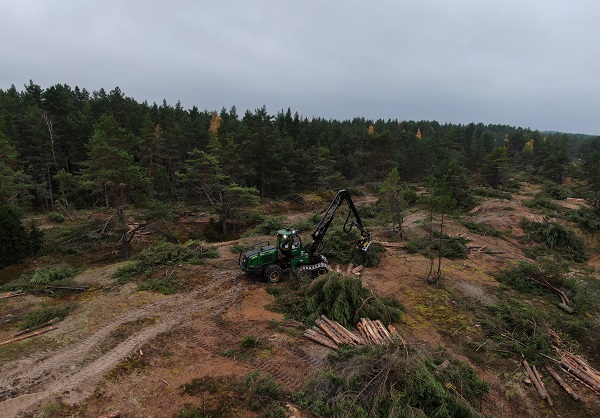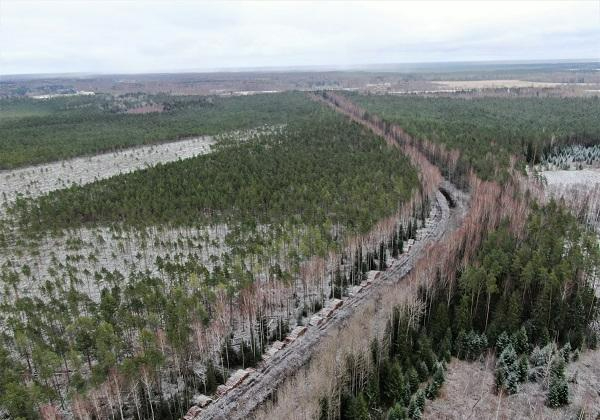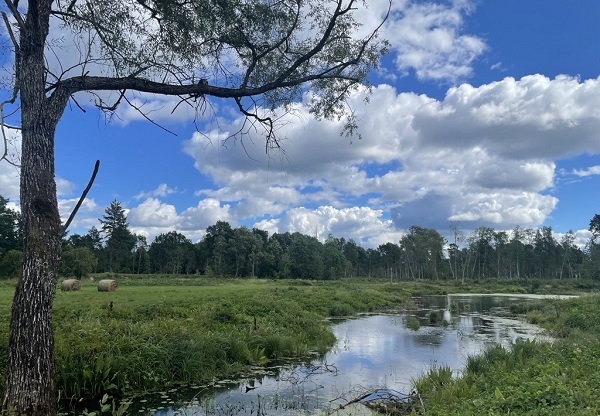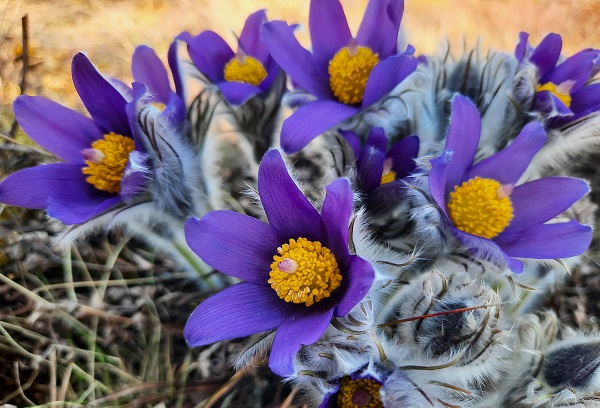LVM has Completed the Second Phase of Works on the Restoration of Habitats of EU Importance and Habitats of Important Species
With the start of the bird nesting season, the second phase of the ambitious restoration and improvement of habitats of European Union (EU) importance and habitats of protected species, carried out by JSC “Latvia's State Forests” (LVM) in a total area of 778 hectares in 13 specially protected natural areas of EU importance Natura2000 and in one micro-reserve have come to an end. In some areas, the works have already been completed, but in others they will continue until the end of this year.
“Since April of last year, when the first stage of the works was completed, we have been actively working in all areas. In general, the works have been completed according to the schedule. In many places during this year, we also encountered a number of challenging situations caused by weather conditions unsuitable for work. We also continued to address the issue of provision of access to territories. For example, a temporary bridge had to be built for the crossing of a river in the Kreiči Swamp – a bundle of pipes was laid in the river, which was covered with trees and branches in two lanes, thus ensuring the flow of water. In most areas, the beneficial effects of the performed works on various environmental values can already be seen,” says Ieva Rove, Head of LVM Environmental Projects.
On 4 April, a meeting of the project steering group was held in the areas of grass restoration of the Liepāja and Tosmare floodplains, where the works are carried out by the project's leading partner, the Nature Protection Board. In the meeting, the works completed so far were evaluated.
“Even though this winter's work season was hard and full of contrasts – from deep snow to multiple winter frosts, habitat restoration works were carried out in almost all of the work execution areas, which in the project totals 1 780 hectares. This was the season when, after careful planning, the works were started even in the most difficult places, and here it is the performance of our partner – LVM, both in the ambitious restoration of the Kreiči Swamp, and the large-scale works carried out in the restoration of the grey dunes on the coast of Kurzeme – that should be emphasized. We cannot fail to mention the contribution of the project to the restoration of a rapidly disappearing natural value in Latvia – meadows. The project includes several Natura 2000 areas where we work only with the restoration of grassland habitats, for example in the nature parks “Abava senleja” and “Engures ezers”, in the nature reserves “Lielupes palienes pļavas”, “Randu pļavas”, “Tosmare”. However, the largest areas of meadow restoration are located in the nature reserve “Liepājas ezers”, where the restoration works of around 100 hectares of floodplain grasslands are organized by the Nature Protection Board; the second most important area in the project is the protected landscape area “Ziemeļgauja”, where the project partner LVM restores almost 100 hectares park-like meadows and pastures that are so characteristic of the “Ziemeļgauja” protected landscape area”, says Inga Hoņavko, Project Manager of the Project's Leading Partner, Nature Protection Board.
Restoration of dunes has been carried out on an unprecedented scale
One of the most extensive works was carried out by LVM in the North Kurzeme region, where the forested seaside dunes are diversified and the grey dunes are restored in three Natura2000 areas: in the nature reserve “Ances purvi un meži”, “Užava” and “Ovīši”.
Dunes in North Kurzeme are the largest work area in the project and, in general, the largest areas in Latvia in which the complex restoration of seaside dunes has ever been carried out.
Diversification works of forested seaside dunes in the nature reserve “Ances purvi un meži” in an area of 75 hectares and restoration works of grey dunes in “Ovīši” in an area of 18 hectares have already been completed.
In the nature reserve “Ances purvi un meži” clearings have been successfully created and the volume of dead wood has been increased. The implemented management measures have potentially improved the occurrence of suitable habitats for several specially protected species in the territory.
Also, the biggest challenges in the nature reserve “Ances purvi un meži” were related to the accessibility of work areas, because there are no stable forest roads in the work area, and it was necessary to use partially passable old natural roads. The works were also hampered by the weather conditions – deep snow and snowstorms, followed by local seasonal floods in the depressions between the dunes outside the work areas.
In turn, the restoration of the grey dunes in “Ovīši” was technically challenging due to the pronounced relief of the facility and the fine sand – these conditions also had to be adapted to the forest equipment used to reduce overgrowth in the dunes.
A complex and bold restoration of a swamp
The restoration works of the Kreiči Swamp in the North Latgale region were carried out under particularly difficult conditions. Both the swamp itself and the transition zone between the swamp and the forest were overgrown with a dense and water-consuming forest under the influence of land reclamation over the years, reducing the value of the swamp and creating unsuitable conditions for the specially protected bird that lives here – the woodpecker. Therefore, during the season of active work last year, any unwanted vegetation was cut on a total of 61 hectares, while the work was carried out over a peat layer up to 4 meters thick. In such conditions, suitable, especially light logging equipment was of great importance, which reduced the risk of the equipment sinking and protected the bog ecosystem. To ensure the carrying capacity, it was also necessary to cover the swamp with the trunks of the removed overgrowth obtained in the area.
The aim of all the works carried out in the swamp is to restore the swamp and bring it closer to its natural state. The works have been carried out on an area of 61 hectares, but the total area of the swamp favourably affected by the works is about 100 hectares. To preserve water in the swamp, seven peat dams will be built on the drainage ditch in 2023 by the end of the year.
The structure of aspen forests has been improved
Extensive works have also been carried out in the restoration of a particularly rare biotope in Latvia – conifer forests on oscillating landforms – in two Natura2000 areas, namely, in the nature park “Driksnas sils” and “Numernes valnis”. In the “Numernes valnis” nature park, trees and bushes unwanted for the rare species of sunflowers were cut down in an area of more than 90 hectares; the works also included the thinning of the undergrowth and the tending of young trees. Some of the felling residue was removed, while some was left in place to dry out the piles of branches in the summer. In the autumn, one part of the branches collected in piles will be burnt on the spot, to create open, sunlit areas and expose the gravel, which is important for the growth of the rare species living here. In turn, the other part of the collected branches will be taken out in the autumn to be chipped and delivered to local boiler houses as fuel. Such works were also carried out in the “Driksnas sils” nature park on an area of 14 hectares.
Both the structure of the aspen forests and the light conditions for the rare species of sunflowers – the pasqueflower, northern dragonhead, sand esparcet – have been improved in the course of the works in both sites.
Meadows will bloom in historical places
Serious work has also continued on the restoration of natural grasslands or meadows in places where they have been there for a long time, but over time, due to lack of management, they have become overgrown. In total, in the course of this project, LVM is to restore natural meadows on an area of 142 hectares in five different Natura2000 areas. The largest work areas are in the area of protected landscapes “Ziemeļgauja” – almost 100 hectares. In half of the “Ziemeļgauja” territory the works have already been completed and grazing has started – the first plants from the seed base in the soil, which are characteristic of biologically valuable grasses, have already started to sprout there. In smaller areas, the work on the restoration of grasslands continued in the other territories as well, such as the nature reserves Ziemeļu purvi”, “Augstroze”, “Melturu sils” and “Lubāna mitrājs” on Leigauņi Island.
The conditions for rare species have been upgraded
During the year, the work on the preservation of the habitats of many rare and important species was also successfully continued, taking care of the hermit beetle in Augstroze, a stand of 12 hectares was thinned for unshading oaks. In the nature reserve “Sakas grīņi”, overgrowth, undergrowth, bush cutting and burning of 16 hectares were carried out to improve the habitat of the specially protected plant species called the cross-leaved heath, preserving intact the trees and other elements specified in the certified nature expert's opinion. In the pasqueflower reserve near Gaigalava, the cutting of unwanted trees and bushes and the thinning and pruning of pine trees were carried out successfully. Already in the course of the works, it was evident that the lighting conditions are significantly improving.
By the end of 2023, LVM, in a total of 14 specially protected natural areas various biotechnical measures will be carried out within the framework of the European Union Cohesion Fund co-financed project No. 5.4.3.0/20/I/001 “Implementation of management measures in specially protected nature territories and micro-reserves to improve the protection status of habitats and species”. The leading partner of the project is the Nature Protection Board.








